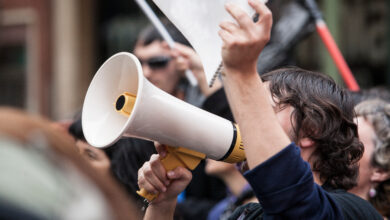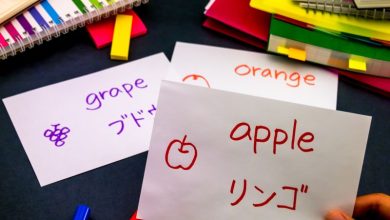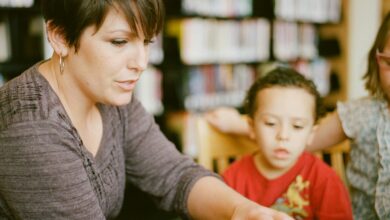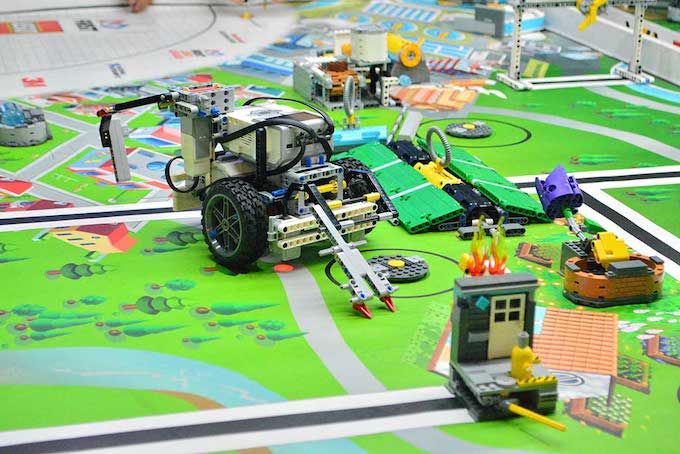
Earlier this year while wandering through the toy aisle at a store an item caught my attention.
The toy, reacted to its surroundings, hurtling itself across the floor with more gusto and louder than the noise from the excited tamariki nearby. It interested me, because I could see the link to Computational Thinking, which sits in the technology learning area within the New Zealand Curriculum. If I were to code it I would break it down. A sensor, reacting to noise. The more noise detected meant more speed moving forward. It seemed fairly accessible for learners, they would be able to grasp the concept behind it. A great metaphor for teaching in some ways – the more that was going on around us the faster we had to move and react.
Mindfulness
The more noise about a topic, the faster we feel we have to move to catch up. But what was the purpose of that toy? Apart from a great Christmas present to annoy a parent, I would have to do some thinking. The new Digital Technologies content can feel a little like this. As teachers, it is hard not to get caught up in the noise but if we allow this, then we miss the best part of this learning area is that we have the space to slow down. We no longer have all the answers or the best ways of doing or even the years of experience behind us to help us choose the best and most relevant parts for our tamariki. What I want to encourage kaiako to do now is to make the most of this opportunity to give back the time and space to our learners and let them find their own authentic context.
Redesigning roles
Kaiako are so used to being givers of knowledge. Able to tackle a task from a variety of angles, rearranging, reevaluating and finding new ways for our tamariki to engage. We have become so good at sharing resources that we know are tried and true, we know what lessons were a success and why. We can change and adapt them in different ways to help those students who need to see it in a different light or context. With the revised digital technologies content this knowledge is, for a lot of us, more foreign. Suddenly we are on the same playing field as our students and, for some of us, it can feel like we are at the beginning again. It can feel uncomfortable. The story of Maui and how he obtained the secret of fire helps us consider the benefits of approaching things in a new way.
His curious nature helped him to think beyond the comfortable norm. Māui’s bravery meant that he fearlessly acted on his hunch to explore beyond current circumstances. His steady tenacity enabled Māui to persevere in his pursuit of a new, more effective solution.
Renee Raroa (2019)
If you are familiar with CORE’s 2019 Ten Trends you will know that one of them is the Changing role of teachers. Where in the past teachers were expected to be givers of knowledge, now we need to look at how we can help our tamariki take risks, celebrate their mistakes as an expected part of the journey, and how we can help them identify authentic needs and help them engage with these needs creatively. The New Zealand curriculum states that;
“Technology is intervention by design. It uses intellectual and practical resources to create technological outcomes, which expand human possibilities by addressing needs and realising opportunities.”
Technology is driven by our desire to create something that can help us. Our outcome could be something that connects people to the land, helps them embrace their culture, assists with communication or understanding. That leaves a wide playing field. How do we narrow down what our purposeful outcome will be? We do this by encouraging our tamariki to look around them and identify problems they can relate to, are passionate about and connected to.
Authentic context
A colleague of mine told me a beautiful story about a kura she was working in. Conversations were started by identifying needs from people they knew, what ideas do we have to address those needs? This brought them to a discussion around how a peer was hearing impaired and as such the school bell was irrelevant for them. They explored this concept and began to talk about lights. The students talked about how lights warn us, convince us or help draw attention to something. From here developed a natural and purposeful inquiry that led to a prototype around how their school could code lights to flash and signal to their peers that the bells had rung. The context was authentic, meaningful for the students, and the outcome was purposeful.
An important discussion and starting place for delivering this content in an authentic context are the discussions around the ethical responsibility we have as creators. Just because we can create something should we? Kia Takatū ā Matihiko, The National Digital Readiness Programme, has a recurring theme around identifying the skills and qualities that help us engage with Digital Technologies. Mahuika, the goddess of fire is one of the characters showcased through the programme. She is a Kaitiaki, a guardian, and when we look for that authentic context to drive these learning opportunities, we need to check and ask ourselves some of these questions.
- What needs do we have in our school or community?
- What are our tamariki passionate or interested about?
- What exists already and how does it work?
- What are our initial ideas or prototypes?
- What could the repercussions of this be? Is our design ethical?
These questions will need to be continually revisited, and at the beginning the outcome or destination that is driving this learning may not be yet clear. Technology in the New Zealand Curriculum has a spotlight section on authentic context which has multiple examples of what teachers have been doing in schools. A quote here from Aaron Duff that sums it up well.
“Authentic learning is not discovered in a textbook, but rather at the crossroads of contemporary societal issues and student passion.”
The challenge with using textbooks, and online resources is that although it can be a wonderful way to initially engage and build confidence around new learning, it tends to take away the authenticity. As soon as you give tamariki a problem to solve you are removing the potential to drive and connect children in a meaningful way. In saying that, your students may well share the same passions as others and sometimes we can be shaped and influenced by seeing examples of innovation. Many schools around New Zealand have embraced taking risks in this space and you can see lots of examples in the resource section of Technology Online or connect yourself with other educators in Aotearoa in spaces such as Ngā Kiriahi. The collaboration available from other tamariki and kaiako can inspire us and help shape our own authentic contexts.
Looking at the potential
What else could authentic context look like? One of the Kia Takatū Meetups this year was held at the Wigram Air Force Museum in Christchurch. Because of the unique opportunity this presented, teachers wanted to give back to the hosts and look at how that partnership could be strengthened, both for the Museum and for the participants. The teachers were invited to create a digital outcome to help with an identified need. The Air Force Museum wanted to engage with educators and their schools more, allow their visitors to interact with the exhibitions and also to have their voice and ideas listened to. They wanted schools to be able to connect with their history and allow more accessibility to more New Zealanders.
The range of responses from our digital creators was impressive. Some of the ideas and prototypes included, a virtual guide, interactive exhibitions, and the creation of LEGO planes that moved and behaved like some of the ones they currently had on display. The idea of using virtual reality to allow access to planes that are no longer open to the public was another discussion point that began to ignite ideas and excite learners as they began to see the potential for various prototypes.
Connection to place
Aotearoa is the perfect place to start connecting tamariki to the technology learning area within the New Zealand Curriculum. Our connection to our physical environment and meaningful ways we can express our culture and identity provides a wealth of starting points for these conversations. There are some incredible technological opportunities currently happening in Aotearoa that you could talk about with your tamariki, and if they were interested you could reach out and get involved.
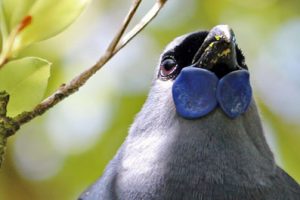
The South Island Kōkako Charitable Trust has recently put out a Facebook post asking for help creating a device to help them locate the once thought extinct South Island Kōkako. You can read more about the Cacophany project here.
This report about a drone eliminating a hornets nest also ignited my interest, as the Department of Conservation currently has a focus on pest control. These ideas are but to name a few and they are definitely biased towards my own personal interests and ideas. So when you start this with your own children think about identifying what is already in your community, and what things are exciting and inspiring for your students.
Thinking back on our hurtling toy, I wonder if we can change the metaphor? Stop and appreciate the quiet, the long pauses where the thoughts start to take place. The action will come, but your job is not to know where you’re going at the beginning, or even halfway through. You may even find the outcome changes constantly the more you find out about it. But the learning is in the journey and with teachers sitting alongside their ākonga. We will make mistakes and we will have lessons that flop. But the opportunity to grow from these mistakes is something to remember, embrace and most of all enjoy.


